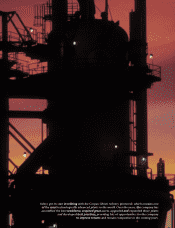Valero 2006 Annual Report Download - page 17
Download and view the complete annual report
Please find page 17 of the 2006 Valero annual report below. You can navigate through the pages in the report by either clicking on the pages listed below, or by using the keyword search tool below to find specific information within the annual report.
VA L E R O E N E R G Y C O R P OR AT I O N 15
Strong Safety, Reliability
& Environmental Initiatives Make a World of Difference
In its annual listing of the “100 Best
Companies to Work For,” Fortune
magazine singled out Valero’s safety
efforts as one of the main reasons
the company once again ranked in
the top 25 among the nation’s best
employers. This was not surprising
because company officials have
always believed that safety is the most
fundamental way of caring for its
employees, contract workers, and the
communities where it operates.
In 2006, Valero’s international refining
network achieved a record-best
total recordable injury rate (TRIR)
of 0.92, which is 25 percent better
than the three-year industry average
of 1.22 reported by the National
Petrochemical & Refiners Association.
This record is the result of significant
safety improvements at all of the
refineries that Valero has acquired
in recent years. In fact, five Valero
refineries finished the year without an
employee lost-time injury.
Valero also works closely with its
contract workforce to ensure that they
maintain high safety standards, and
as a result, the company reached a
record contractor TRIR of 1.03 in 2006
– a 26 percent improvement over the
previous year.
Since 2001, Valero employees and
contractors have assumed even higher
safety standards through participation
in the OSHA Voluntary Protection
Program (VPP), and today Valero has
11 VPP Star Site refineries – more
than any other refiner. Out of 149
U.S. refineries, only 23 have met the
rigorous qualifications to earn this
distinction, and Valero owns nearly
half of those sites. And, the company’s
remaining refineries are on track to
earn this prestigious certification in the
coming years.
Another important benefit of VPP is the
program’s strict adherence to OSHA’s
rigorous Process Safety Management
(PSM) regulations. Valero’s focus on
PSM and its PSM-related programs
are critical to the company’s efforts
to maintain operational integrity and
reliability at all of its sites.
Safe and reliable operations are also
essential to strong environmental
performance, another area where
Valero has seen steady improvement
in recent years. Between 2001
and 2005, Valero reduced criteria
emissions by 19,130 tons per year, or
nearly 26 percent, while increasing
charge capacity by almost 240,000
barrels per year, or almost 14 percent.
Much of Valero’s emission reductions
are a result of major investments in
state-of-the-art emission reduction
technology. And, these investments
are in addition to the billions of dollars
that Valero has invested to produce the
clean fuels that adhere to new clean
fuels standards and meet the growing
demand of U.S. consumers.
Valero will continue to be on the
forefront of safety initiatives and
environmental technology, and remain
committed to sharing best practices
from within its operations and
throughout the industry. After all, safe
operations are a safe investment.
Valero’s Commitment to
GHG Emission Reductions
As Valero continues working to meet
our nation’s growing demand for clean
fuels, the company is also committed
to reducing greenhouse gas (GHG)
emissions. Valero is investing in the
latest technology to improve combustion
and energy efficiency at its refineries,
which will reduce fuel consumption and
carbon dioxide emissions over the next
several years.
Valero also supports market-based
mechanisms and incentives to ensure the
most economic sources of GHG emission
reductions are realized.
Valero will continue to closely follow
regulatory developments, and participate
in professional and public policy
forums that address climate change
and its potential impacts.
Through careful scientific, economic,
and technical analysis, the company
will work with all stakeholders to
develop long-term measures that
protect the environment.
























